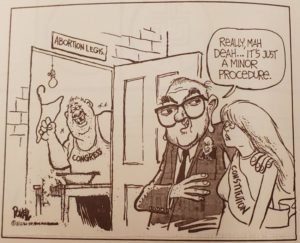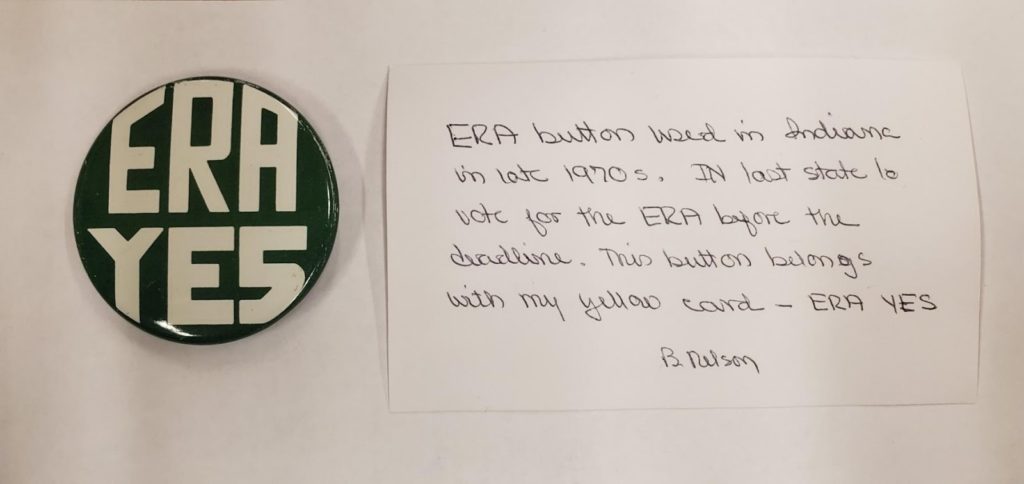Posted on December 10, 2019 by small20
The Anti-Feminist: the Dark Side of the Revolution
by Grant Barnett
This blog will examine materials in Purdue Archives and Special Collections that illuminate the arguments of antifeminists and feminists on campus in the 1970s and 1980s. In exploring anti-feminism, I have decided to focus on two controversial issues: abortion and the Equal Rights Amendment (ERA). These two issues caused controversy and prompted relatively clear arguments by both sides. I loosely define anything that is for abortion or the equal rights amendment as pro-feminist and anything against abortion or the ERA as anti-feminist. This distinction is useful for the blog’s categorization and juxtaposition of views, but does not mean that anyone who has an anti-feminist opinion is not a feminist or anti-woman.
Some of the views and opinions are quite controversial. I wish to make it clear that the views and opinions expressed in the blog post are not necessarily my own. The opinions that are expressed here held by people at Purdue during the 1970s and 1980s, and found in the Purdue Archives. I also do not endorse any opinion; I am simply creating a record of them for historical and educational purposes.
Abortion
“So please, call me pro-life, not anti-choice.” Janet L. Wagner [1]
The national feminist movement has been a supporter of abortion rights for many years. The common argument is that women need to have sovereignty or control over their bodies. Feminists argue that it is a right the women need to have, in order to best live their lives, and ensure their health and welfare. One of the most important main arguments for abortion is that the government is trying to make moral judgments about what a woman can and cannot to her body. [2]

Anti-feminists have traditionally been against abortion. They believe that abortion is an issue of life and morality rather than choice and health. The best way to sum up this is with the oft used phrase: abortion is murder. The moral justification for abortion being murder, is that the fetus is a living human being, and that abortion is the act of murdering the fetus. Those against abortion tried to pass a right to life amendment in the constitution, hoping to overturn Roe v. Wade. The amendment never got very far, but it stands as a testament to the beliefs of anti-abortionists. [4]

The two groups’ arguments differ in their priorities. Feminist arguments hold that choice and sovereignty over one’s body is more important. The feminists do not focus on the moral implications of an abortion, but rather the legal danger of abortion, women’s bodies, being legislated. The anti-feminists are concerned with the moral repercussions of abortion. The anti-feminists are often not concerned with the legal implications of banning abortion. The two sides are in such heated and unresolvable conflict because they are speaking a different language, whether it be moral or legal. [6]
Purdue’s Sisters for Health Education (S.H.E.) worked to promote pro-choice policies at Purdue and teach women about their medical options. Others in the community fought against abortion. But not all did so from an antifeminist position. Ms. J. Smith, for example, who wrote a piece against S.H.E. and abortion, did so from a feminist perspective. Ms. Smith argued that abortion was approved by the all-male Supreme Court, so that men wouldn’t have to be responsible for pregnancies. [7]
Equal Rights Amendment
“God put man over all the animals of the Garden of Eden, including women.”
~Marget Scherf [8]
The feminist movement was the main advocate for an Equal Rights Amendment. The amendment would make it illegal to discriminate against a person based upon their gender. Advocates for the ERA focused on laws that discriminated against people on the basis of gender and sought the amendment to stop gender discrimination. The arguments for the amendment would sometimes focus on the possibility that there could be sweeping legislation, passed in the future, in the United States that would allow for discrimination against women. To fight against this, ERA advocates argued that it was necessary to have legal protection against discrimination, based on gender. The amendment sought to affirm the Fourteenth Amendment’s equal protection guarantees. [9]

Conservative groups were mostly against the ERA. The reason seemed to be the uncertainty of the legal implications of such an amendment to the Constitution. Many attorneys feared that laws that made men pay alimony, blocked gay marriage, and legislated rape and prostitution would come under threat. The possible ramifications of the ERA on existing laws made it so that there was never any consensus on the exact effects of the amendment. [11]

Some feminists were against the ERA. At the National Women’s Conference, in Houston, in 1977 there was heated disagreement over abortion and the ERA. The conference was divided between “Steinems” and “Schlaflys.” “Steinems” were named after Gloria Steinem, who was a leader in progressive feminist politics, and “Schlaflys” where named after Phyllis Schlafly, who was a conservative woman leader. Schlafly argued that women’s place is in the home where they find their greatest fulfillment. [13]

In our lives we live through situations with much nuance and due to our proximity with the nuance in our lives we can understand it. However, it is difficult to understand the nuance and situations of another’s life. As discussed in the post above, there was no complete solidarity on issues in the feminist movement, with abortion or the ERA.
It is my hope that I have represented the views of all sides fairly and well, and that you are able to see the arguments in their different lights. Neither side of an argument is possessed by an evil and are fighting against your rights, but the other side often has a differing viewpoint on the issue. The materials discussed here demonstrate the range of opinion on controversial issues among students, faculty, and staff at Purdue in the 1970s and 1980s. It is important to view the argument from the opposite side and try to find the nuance in your own and others’ opinions. Most people that fight against something that you believe in are not doing it out of malice.
[1] Janet L. Wagner, “Pro-Life, Not Anti Choice,” Letter to the Editor, Lafayette Journal and Courier, April 30, 1989.
[2] Walter Isaacson, “The Battle over Abortion,” Time, April 6, 1981; “Legal Abortion: Pro & Con,” Westchester [NY] Coalition for Legal Abortion, n.d., Box 2, Folder 6, MSP 150 Sisters for Health Education, Purdue Archives and Special Collections, Purdue University.
[3] Isaacson, “The Battle over Abortion.”
[4] Wagner, “Pro-Life, Not Anti Choice”; “Right to Life Amendment,” Raleigh News and Observer, n.d., Box 2, Folder 6, MSP 150 Sisters for Health Education; “Legal Abortion: Pro & Con”; Ms. J. Smith, Pro-choice Article, 1981, Box 1, Folder 3, MSP 150, Sisters for Health Education Records; Isaacson, “The Battle over Abortion.”
[5] “Right to Life Amendment,” Raleigh News and Observer, n.d.
[6] Wagner, “Pro-Life, Not Anti Choice”; “Right to Life Amendment,” Raleigh News and Observer, n.d.; “Legal Abortion: Pro & Con”; Ms. J. Smith, Pro-choice Article, 1981; Isaacson, “The Battle over Abortion.”
[7] S.H.E. Response Letter, 1981, Box 1, Folder 3, MSP 150, Sisters for Health Education Records; Ms. J. Smith, Pro-choice Article, 1981.
[8] Marget Scherf, “The Equal Rights Amendment,” Washington Post, April 23, 1972, Box 21, Folder 4, MSF 334, Helen Schleman Papers, Purdue Archives and Special Collections, Purdue University.
[9] Scherf, “The Equal Rights Amendment”; “That Equal Rights Amendment,” New York Times Magazine, September 20, 1970, Box 21, Folder 4, MSF 334, Helen Schleman Papers.
[10] ERA YES, n.d., Betty Nelson Papers, Purdue Archives and Special Collections, Purdue University
[11] “The Equal Rights Amendment a Trojan Horse,” Evansville, IN, Regional Stop-E.R.A., n.d., Betty Nelson Papers; Scherf, “The Equal Rights Amendment”; “That Equal Rights Amendment.”
[12] “The Equal Rights Amendment a Trojan Horse.”
[13] Two Sides to Women’s Issues, Box 24, Folder 2, MSP 334, Helen Schleman Papers; Susan Fraker and Elaine Sciolino,“Women vs. Women,” Newsweek, July 25, 1977, Box 24, Folder 2, MSF 334, Helen Schleman Papers.
[14] Fraker and Sciolino, “Women vs. Women.”
Banner Image Reference in bold.